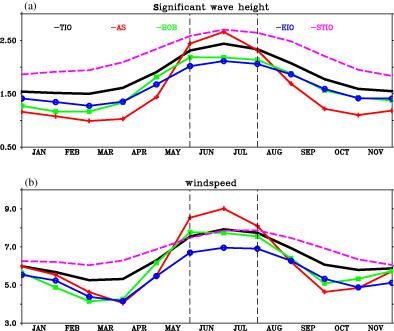当前位置:
X-MOL 学术
›
Int. J. Climatol.
›
论文详情
Our official English website, www.x-mol.net, welcomes your feedback! (Note: you will need to create a separate account there.)
The impact of Indian Ocean dipole on tropical Indian Ocean surface wave heights in ERA5 and CMIP5 models
International Journal of Climatology ( IF 3.9 ) Pub Date : 2020-10-22 , DOI: 10.1002/joc.6900 Gangiredla Srinivas 1, 2 , P. G. Remya 1 , B. Praveen Kumar 1 , Anuradha Modi 1 , T. M. Balakrishnan Nair 1
International Journal of Climatology ( IF 3.9 ) Pub Date : 2020-10-22 , DOI: 10.1002/joc.6900 Gangiredla Srinivas 1, 2 , P. G. Remya 1 , B. Praveen Kumar 1 , Anuradha Modi 1 , T. M. Balakrishnan Nair 1
Affiliation

|
The present study examines the relationship between the tropical Indian Ocean (TIO) significant wave height (SWH) and Indian Ocean dipole (IOD) during boreal summer season (June through August) in the latest version of European Centre for Medium‐Range Weather Forecasts reanalysis (ERA5) and wave simulations forced with surface winds and sea‐ice fields from the Coupled Model Intercomparison Project version‐5 (CMIP5) models. The interannual variability of SWH shows a significant negative correlation with the IOD over TIO. SWH anomalies display meridional tripole pattern with significant negative (positive) anomalies over eastern equatorial Indian Ocean caused by anomalous easterlies (westerlies), and positive (negative) anomalies over southeastern TIO and the north Bay of Bengal during positive (negative) phase of IOD. The strong wave heights along the east coast of India during positive IOD and the south and southwest coast of India during negative IOD are noticed. CMIP5 models GFDL‐CM3, MRI‐CGCM3 and the multi‐model mean display considerable skill in capturing these teleconnections with substantial magnitude differences. A thorough understanding of the teleconnections between IOD and TIO wave heights is a significant prerequisite for the accurate forecast of surface waves in the Indian Ocean. Hence, this study advocates the importance evaluating the ability of models in representing the SWH and IOD interactions and its implications on Indian coastal regions in the form of inundation, coastal flooding and other vulnerabilities in a changing climate scenario.
中文翻译:

在ERA5和CMIP5模型中印度洋偶极子对热带印度洋表面波高度的影响
本研究在最新版本的欧洲中距离天气预报中心最新分析中,研究了北方夏季(6月至8月)热带印度洋(TIO)的重要波高(SWH)与印度洋偶极子(IOD)之间的关系。 (ERA5)和波浪模拟,这些模型来自“耦合模型比较项目”第5版(CMIP5)模型中的地表风和海冰场。SWH的年际变化与TIO上的IOD呈显着负相关。SWH异常显示子午线三叉形模式,赤道东印度洋(西风)异常导致赤道东印度洋出现明显的负(正)异常,而在IOD的正(负)相期间,东南TIO和孟加拉北部湾的正(负)异常。在IOD为正值期间,印度东海岸和IOD为负值期间,印度南部和西南海岸的波高很强。CMIP5模型GFDL-CM3,MRI-CGCM3和多模型均值在捕获具有巨大幅度差异的这些遥距连接方面显示出相当大的技能。透彻了解IOD和TIO波高之间的遥相关性是准确预测印度洋表面波的重要先决条件。因此,本研究主张评估模型在代表SWH和IOD相互作用方面的能力及其对印度沿海地区的影响的重要性,这些模式包括洪水,沿海洪水和气候变化情况下的其他脆弱性。
更新日期:2020-10-22
中文翻译:

在ERA5和CMIP5模型中印度洋偶极子对热带印度洋表面波高度的影响
本研究在最新版本的欧洲中距离天气预报中心最新分析中,研究了北方夏季(6月至8月)热带印度洋(TIO)的重要波高(SWH)与印度洋偶极子(IOD)之间的关系。 (ERA5)和波浪模拟,这些模型来自“耦合模型比较项目”第5版(CMIP5)模型中的地表风和海冰场。SWH的年际变化与TIO上的IOD呈显着负相关。SWH异常显示子午线三叉形模式,赤道东印度洋(西风)异常导致赤道东印度洋出现明显的负(正)异常,而在IOD的正(负)相期间,东南TIO和孟加拉北部湾的正(负)异常。在IOD为正值期间,印度东海岸和IOD为负值期间,印度南部和西南海岸的波高很强。CMIP5模型GFDL-CM3,MRI-CGCM3和多模型均值在捕获具有巨大幅度差异的这些遥距连接方面显示出相当大的技能。透彻了解IOD和TIO波高之间的遥相关性是准确预测印度洋表面波的重要先决条件。因此,本研究主张评估模型在代表SWH和IOD相互作用方面的能力及其对印度沿海地区的影响的重要性,这些模式包括洪水,沿海洪水和气候变化情况下的其他脆弱性。


























 京公网安备 11010802027423号
京公网安备 11010802027423号